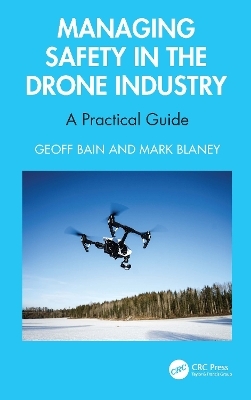
Managing Safety in the Drone Industry
CRC Press (Verlag)
978-1-032-61146-4 (ISBN)
- Lieferbar (Termin unbekannt)
- Versandkostenfrei
- Auch auf Rechnung
- Artikel merken
The drone industry is one of the most exciting and dynamic sectors in the modern world, growing and developing at an exponential pace. With an increase in the usage numbers and technological sophistication advances of these devices, their future development and application are only limited by our imagination. Managing Safety in the Drone Industry: A Practical Guide has been written with the aim of helping those involved in drone operations develop safety structures and practices capable of tackling the increased risk of accidents and incidents as more drones of various sizes begin to fill our skies.
This book is designed to suggest practical guidelines for managing safety primarily for the new drone industry, particularly those of a safety critical nature. Based upon the author’s 50 years of experience in the Aviation Industry, this book uses tried-and-tested best practices and current aviation principles adapted to drones and attempts to predict the trends of evolution which are believed to become mandatory regulations in the future. Real-life case studies are aligned with the text. Written in a style that adopts short and succinct chapters, this guide will allow the reader a thorough overview of drone safety and the future trends that the industry will face.
This book is an ideal read for any professional working in a safety critical industry needing practical guidance on drones or manned aviation. It will particularly appeal to those in aviation, health and safety, logistics, business, and management and in any industry using or considering the use of drone technology for their operations.
Geoff Bain is a retired Airline Training Captain and Flight Simulator Instructor, with 55 years’ experience flying worldwide on 32 different aircraft types and totalling 16,500 hours. He now delivers Human Factors and Safety Management System training for all industries. He specialises in unmanned aerial vehicles, fixed wing and rotary operations developing training programmes. Mark Blaney has worked in the UAS industry since 2008. Initially a Military UAV Operator and Intelligence Analyst in the Royal Artillery, Mark operated the Hermes 450 Tactical UAV, and deployed to Afghanistan twice in this role. After leaving the British Army in 2014, Mark then worked as a Chief Remote Pilot for a UK-based fixed-wing drone manufacturer. Since 2015 Mark has been employed as an RPAS Instructor, firstly at a National Qualified Entity (NQE) in South Wales, and since 2020 by the Recognised Assessment Entity (RAE) heliguy™. Mark took on the role of Head of Training for heliguy in 2021 and recently moved into the Accountable Manager role. In his time at heliguy™, Mark has written and developed training course content, most notably the TQUK Level 5 Award for UAS Operations Managers.
Preface
Author Introduction
Co Author Introduction
Target Audience and Overview
Acknowledgements
Development
Acronyms and Abbreviations
Definitions
Part One Integrated Safety Management Systems
Chapter 1 – Safety Management Systems Overview
Chapter 2 - Safety Policy and Objectives
Chapter 3 - Safety Risk Management
Chapter 4 - Safety Assurance and Compliance
Chapter 5 - Safety Promotion
Part Two – Human Factors
Chapter 6 - Human Factors (HF), Crew Resource Management (CRM), Team Resource Management (TRM).
Chapter 7 – The Basic Cognitive Functions
Chapter 8 – The Social Skills
Chapter 9 – The Practical Application
Chapter 10 – The Wellness Skills
Chapter 11 – The Assessment Proces
Chapter 12 – Job Specific Human Factors
Part Three – Accident /Incident Investigation/ Case Studies
Chapter 13 - Accident / Incident Investigation /Case Studies Overview
Part Four – Education
Chapter 14 – Teaching and Learning
Part Five – Leadership and Management
Chapter 15 - Leadership and Management
Part Six – Practical Application in the RPAS (Drone) Industry
Chapter 16 - RPAS Operational Oversight
Chapter 17 – Understanding the importance of UAS Maintenance
Chapter 18 - Organising a Flight Safety Meeting
Chapter 19 - Flight Readiness Review
Chapter 20 - Future of Unmanned Aircraft Systems
Chapter 21 – Preparing an Operational Safety Case
Chapter 22 -- Understanding the Auditing Process for UAS Operators
Part Seven - Research
Chapter 23 - DRONOTS
Chapter 24 - Using the COM – B method for influencing behaviour change in training.
Part Eight – Resources, Links and Recommendations
Index
| Erscheinungsdatum | 02.11.2024 |
|---|---|
| Zusatzinfo | 51 Line drawings, black and white; 20 Halftones, black and white; 71 Illustrations, black and white |
| Verlagsort | London |
| Sprache | englisch |
| Maße | 156 x 234 mm |
| Themenwelt | Informatik ► Theorie / Studium ► Künstliche Intelligenz / Robotik |
| Technik ► Fahrzeugbau / Schiffbau | |
| Technik ► Luft- / Raumfahrttechnik | |
| Technik ► Umwelttechnik / Biotechnologie | |
| Wirtschaft ► Volkswirtschaftslehre | |
| ISBN-10 | 1-032-61146-4 / 1032611464 |
| ISBN-13 | 978-1-032-61146-4 / 9781032611464 |
| Zustand | Neuware |
| Haben Sie eine Frage zum Produkt? |
aus dem Bereich


